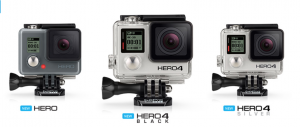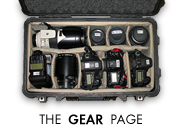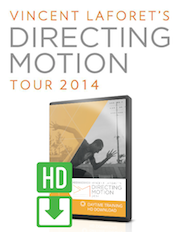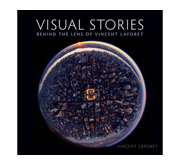The GoPro & it’s place in History
When I look back at the history of photography and film, and notably the tools that have been instrumental in defining that path, I have to say that the GoPro camera may just be one of the most significant cameras ever invented.
I grant you that that is a pretty bold statement. But keep in mind that I am not just looking at just the "tool itself", but more broadly on the impact that a tool has have on how people in general interact with photography and film.
I have seldom seen so many "no professionals" (AND professionals) gravitate so quickly towards a camera, and be so excited to "document" their lives with such ease. Very few cameras in history have had as large of an impact on the evolution of image capturing as the GoPro. In fact more than half of all video cameras sold last year in the USA were… yep: GoPros.
For photographers, the Leica started it all. Born out of the need to process small sections of motion picture film (instead of entire film reels) in order to better judge exposure, the 35mm format and notably the incredibly compact and precise Leica rangefinder cameras are legendary tools for photographers, including myself, to this day. It is in fact my go to camera for documenting the lives of my children, second only to my iPhone and more recently the Fuji X100s.
Then, Kodak’s Brownie camera was a watershed moment in the history of still photography, just as 16mm cameras were for budding filmmakers. The format and relatively low cost made photography accessible to all and that led to it’s proliferation into the general populace and within families – as opposed to being a high end (read: expensive, and complicated to learn & operate) tool reserved for full-time professionals.
Then in 2007, (just 7 years ago!!!) The iPhone led to the single biggest explosion in photography ever. Take away the still photograph from Facebook, and ask yourself if Facebook could be anywhere near what it is today without it. The iPhone in fact soon surpassed all DLSRs as the most popular cameras in the world just a few short years after its launch.
The Canon 5D MKII & "HDSLR Revolution "changed things as well, but I think the GoPro’s launch in 2010 affected many more people than any DSLR ever has – and the numbers back that up quite clearly.
Think about it.
More than 14 billion images will be shot this year alone according to Yahoo!

And while the iPhone/Smartphone may be the camera of the future, there are notable technologies such as Lytro and others yet-to-be-released that are fighting for a seat at the table…
But there is another player that already has a well worn seat at the table, in this case it’s The GoPro and it’s earned that seat in the way it has fundamentally changed the way people interact with the "camera" itself. And that is a VERY big deal in my book.
First of all, the latest iteration of the GoPro, the Hero 4, is the tool that most of us have been waiting for. While the GoPro hero 3 came nearly 2 years ago, expected battery issues stood in the way of what seemed like the perfect camera at the time. The Hero 3+ was another step in the right direction, and I found myself relying on those cameras much more often on a variety of projects – but you couldn’t QUITE get 24p 4K video… With the Hero 4 – now you can, and with manual exposure control (finally!) as well as extremely high frame rates.
My reasoning for calling this camera a breakthrough tool has nothing to do with what professionals are shooting with it to be honest… And it should be pointed out that no matter what show you watch today on TV there’s a strong likelyhood that the shows are using a GoPro at one point or another… But, one might say that to determine the impact of a camera, one shouldn’t be looking to what tools professionals are using, one should be looking to what tools EVERYONE is using and how they are engaging in photography and film.
And that is where the GoPro has re-defined things – it has singlehandedly re-defined the way the average person interacts with photography and film and how they capture important and "everyday" moments in their life – from motorcycle rides across the planet to videos of their pets’ POV. And I’ve only seen that happen with the cameras I mentioned above. It’s a pretty rare thing.
The GoPro has fundamentally changed the way professionals and amateurs interact with the "camera."
Or more to the point and especially in this case “don’t” interact with the tool. The GoPro more so than any tool that ever preceded it, has allowed people to focus more on experiencing the moment, as opposed to focusing on capturing it. And I think the way people interact with the GoPro is different than the way that they interact with their smartphones – in that it’s in a much more passive "hands" off way, which allows them to enjoy their moments "uninterrupted" by the gizmo itself.
When you combine the camera’s small size, very low relative cost, lightweight nature, and having a protective/waterproof case that makes it feel almost indestructable with the ability to mount it to one’s body, helmet, or vehicle, (or animal!) what you have is a watershed event in photography history.
While many of you have only known photography during its digital days… some of us grew up for better or worse using silver halide film. The hardest part in those days was the guesswork… the waiting. One never knew if you “had” the image in the can. There was no immediate satisfaction and that was part of the allure to many of us. Often, if you’d seen the image with your own eye, you’d likely missed it on film. Regardless, you have to wait half an hour to several days or weeks to get your film back to find out if you should continue to engage in your expensive hobby, or move on to something else.
This to me, was by far from the most frustrating part of photography when it came to doing it professionally, on deadline and with high levels of pressure. At the time there was no autofocus, no LCDs. and it seemed that the camera and it’s complexity often stood as one of the main obstacles to someone obtaining a great image, and more to the point to actually "enjoying" the process. It felt at time, far too technical and mysterious of a challenge for most. It felt particularly frustrating to non-professionals and kept many away from the field altogether.
Perhaps just a spectacular, is the marketing behind this camera. He and his sister Pilar Woodman, along with Bradford Schmidt, have pulled off one of the most successful series of viral marketing campaigns in recent memory.
What is equally as impressive is GoPro’s partnership with Red Bull and its athletes. Not only did they find some of the best athletes in the world doing the most insane stuff, they also found incredibly willing partners and participants all in one fell swoop. Hip, young, visual and super dynamic – without million-dollar commercial production budgets. That’s pretty ingenius, you have to give it to them for effectively helping to re-define a new way of marketing a brand.
But GoPro has also managed to find a way not to loose sight of the fact that "everyday moments" are just as important… nothing beats genuinely great content, whether it’s a father and son sending a balloon into space with a GoPro attached, or a baby taking its first steps.
In the end, the ultimate goal of any technology in my opinion, is to get out of its own way. In other words, the best technologies are ones you never notice or pay attention to, and that’s what The GoPro has done, it is the ultimate “fire and forget” Camera.
GoPro has an interesting challenge ahead… The size, weight, cost and quality of their sensor of their current model is pretty hard to beat, while it does not compete with a DSLR in low light, or in terms of sensor size, one of the biggest challenge facing them going forward is lensing and how the camera can evolve beyond its current form factor (beyond Apple-like speed and spec upgrades.) Only time will tell where they choose to go in terms of offering different lensing options going forward – which is thet the exact same dilemma facing the iPhone – and how they continue to innovate going forward.
It’ll be interesting to see where the GoPro will be come the Hero 8!
I know that as far as I’m concerned the GoPro has clearly gone from the "gadget" category and evolved into a professional tool that I can use on almost any production.
The question for me is: will I be calling it an "A" Camera in a few years? And does that matter? Has GoPro already won the true battle … by winning the hearts and minds (and pocketbooks!) of the non-professional?
Has it won because it focused more on making sure that users were able to forget the camera and to stay focused on enjoying the experience as opposed to focusing on the act of capturing it?
I think so…













I was amazed when I saw our aerial 2K 24p footage from the Hero 3+ – Remember thinking.. ” This is better than my A cam and should have cost $11,000 to get.”